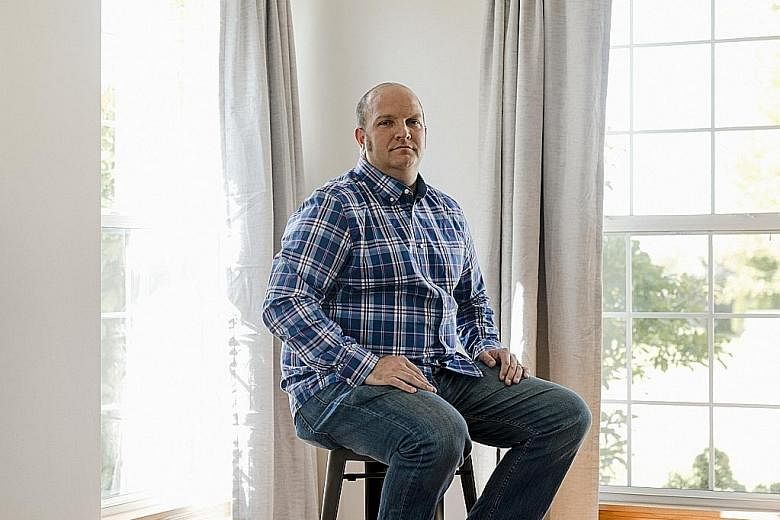KENOSHA • Tapping on his cellphone with a sense of purpose, Mr Kevin Mathewson, a former wedding photographer and one-time city alderman in Kenosha, Wisconsin, did not slow down to fix his typos as he dashed off an online appeal to his neighbours.
It was time, he wrote on Facebook in late August, to "take up arms to defend out (sic) City tonight from the evil thugs".
One day earlier, hundreds of residents had poured onto the streets of Kenosha to protest against the police shooting of 29-year-old Mr Jacob Blake. Disturbed by the sight of buildings in flames when he drove downtown, Mr Mathewson decided it was time for people to arm themselves to protect their houses and businesses.
To his surprise, some 4,000 people responded on Facebook.
Within minutes, the Kenosha Guard had sprung to life.
His call to arms - along with similar calls from others inside and outside the state - propelled civilians bearing military-style rifles onto the streets, where late that night a teenager scuffling with protesters shot three of them, two fatally.
The Kenosha Guard then evaporated just as quickly as it arose.
Long a divisive figure in Kenosha, Mr Mathewson, 36, who sprinkles his sentences with "Jeez!" and describes himself as "chunky", does not fit the typical profile of a rifle-toting watchdog, although he said he supported President Donald Trump on Second Amendment grounds.
The rise and fall of his Kenosha Guard reflects the spirit of vigilantism surfacing across the United States. Organisations that openly display weapons have existed for decades, with certain hot-button issues like immigration or Second Amendment rights inspiring people who think the US Constitution is under threat.
Anti-immigrant and Islamophobic sentiments are rife, and some militant groups, like the Oath Keepers or the Three Percenters, train together under established hierarchies.
Ever since the 2017 white nationalist march in Charlottesville, Virginia, armed groups have become fixtures at demonstrations around the country, although membership numbers remain opaque.
With the approaching election ratcheting up tensions in recent months, armed groups that assembled via a few clicks on the keyboard have become both more visible and more widespread.
Some especially violent groups were rooted in longstanding anti-government extremism, like the 14 men charged with various crimes in Michigan this month. They included six accused by the Federal Bureau of Investigation of plotting to kidnap Governor Gretchen Whitmer, whom the suspects had labelled a "tyrant".
Starting in April, demonstrations against coronavirus lockdowns prompted makeshift vigilante groups to move offline and into the real world. That trickle became a torrent amid the nationwide protests after the police killing of Mr George Floyd in Minneapolis - with some armed groups claiming to protect the protesters while others sought to check them.
"They just spawn out of nowhere," said Ms J.J. MacNab, a fellow at George Washington University's Programme on Extremism.
Experts who study violent groups say many are technically not militias; they are too unstructured and do not undertake basic steps like training together.
The Second Amendment may mention a "well-regulated militia", but all 50 US states ban private paramilitary groups, said Ms Mary McCord, a former senior Justice Department official now at Georgetown University Law Centre.
Mr Mathewson first tried to muster the Kenosha Guard in June after the city had small protests because of Mr Floyd's death in Minnesota. A little more than 60 people responded.
Then, on Aug 23, video emerged that showed a Kenosha police officer firing seven times towards Mr Blake's back. When protests disintegrated into property destruction, Mr Mathewson said, he thought law enforcement was overwhelmed.
After two nights of demonstrations, he posted an event on Facebook called "Armed Civilians to Protect our Lives and Property".
He named himself commander of the Kenosha Guard and added an open letter to police telling them not to interfere.
"That got a lot of traction," Mr Mathewson said. "Tons and tons of shares, likes, comments."
Several hundred people volunteered to participate and around 4,000 expressed approval. His call to arms spread to other platforms.
As tensions surged, with protesters and armed enforcers tussling, the authorities said Kyle Rittenhouse, a 17-year-old from nearby Illinois, opened fire with a military-style semi-automatic rifle, killing two protesters and seriously wounding a third. He faces homicide charges and has become a poster boy for the far right.
Mr Mathewson remains unsure which armed men downtown responded to his call. He said what he did was covered by free speech.
After the shootings, Facebook banned Mr Mathewson for life, removing his personal and professional pages.
Mr Mathewson said that for now he has no plans to revive the Kenosha Guard. His wife has had enough of the spotlight, he said, with his phone ringing constantly.
"I am getting love and hate from all over the country," he said.
NYTIMES


